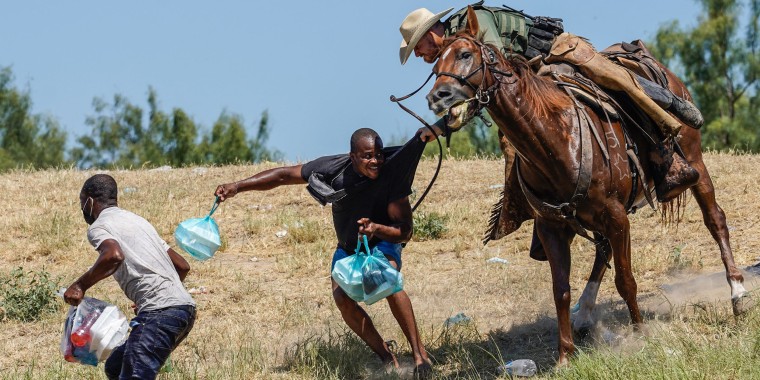Only in America would last year’s shocking image out of Del Rio, Texas, of a Border Patrol agent on horseback chasing down a Black Haitian migrant like a modern-day slave patroller become a collector’s coin sold on eBay. According to reports, the coin, which includes the phrases “Reining it in since May 28, 1924” and “Yesterday’s border is not today’s border” and “You will be returned” is being shared among Border Patrol agents, who are known to have shared similar memorabilia in the past. In 2019, agents were circulating a coin mocking migrant children.
Only in America would last year’s image of a Border Patrol agent chasing down a Black Haitian migrant become a collector’s coin.
Last week The New York Times quoted a spokesperson for the U.S. Customs and Border Protection saying, “The images depicted on this coin are offensive, insensitive and run counter to the core values of C.B.P.” That spokesperson said the agency intends to investigate whether any CBP employee created, sold or bought the coin and would send cease-and-desist letters to those responsible for the unauthorized use of the Border Patrol logo.
Still, considering the history of inaction from CBP and the Department of Homeland Security (DHS) after promising to investigate the apparent violence against Haitian migrants in Del Rio in September, there is little expectation that a CBP inquiry into yet another racist coin will mean anything. When the images sparked global outrage, President Joe Biden’s condemnation was immediate, indicating that maybe the United States would finally admit part of its immigration enforcement policy is indeed racialized—whether it is against Haitians, Mexicans, Central Americans or other migrants from the Global South.
“I promise you, those people will pay. There will be an investigation, underway now, and there will be consequences. There will be consequences,” Biden said in September. “It's an embarrassment, but beyond an embarrassment, it is dangerous. It’s wrong, it sends the wrong message around the world, it sends the wrong message at home. It's simply not who we are."
Homeland Security Secretary Alejandro Mayorkas, however, defended the actions of Border Patrol agents in Del Rio, saying in September that they had acted “heroically”; even so, he told a congressional committee that an “all-encompassing” investigation into the horseback images would “be completed in days.” According to what DHS shared last November, an inquiry was still happening, but so far, the public knows nothing regarding the status of that investigation.
Those delays suggest the coin investigation won’t be a priority either, no matter what CBP is saying.
Americans must come to terms with the Border Patrol’s deeply racist history and the truth that some modern-day Border Patrol agents think of themselves as warriors in the fight against the so-called great replacement. The Biden administration has called on Congress to add more funding to investigate white supremacist beliefs at immigration enforcement agencies. The coins being circulated and bought are proof that such beliefs not only exist but also are celebrated.
Ironically, 50 percent of those Border Patrol agents are Latinos. Then again, perhaps it’s not so ironic. As much as CBP would like to tout its diversity numbers, it’s no secret that Latinos are diverse ideologically and that some are allies to white supremacy. A place like Border Patrol can feel like home.
Americans must come to terms with the Border Patrol’s deeply racist history and the truth that some modern-day Border Patrol agents think of themselves as warriors in the fight against the so-called great replacement.
The searing image of a terrified Haitian migrant being mocked on a coin should not be ignored by Americans. The person we saw being chased and depicted on that coin has a name. He’s Mirard Joseph. He has been deported back to Haiti — like so many thousands of other Haitians during the Biden administration — but Joseph is fighting back by suing the U.S. government.
The Miami Herald reported that Tess Hellgren, one of the lawyers representing Joseph and other Haitian asylum-seekers, called the coin a “celebration and commodification of racist violence.” That’s exactly the kind of language we must use when speaking of this outrage.
The coin gleefully depicting Joseph’s terror is no different from the Reconstruction-era lynching postcards that, as one account puts it, were “often inscribed with racist texts or poems, to be distributed, collected, or kept as souvenirs.”
State violence against Black people takes many forms, and until there is a larger outcry to condemn it each and every time it appears, there will be no change. New variations of lynching postcards will keep appearing and even be circulated among agents who claim “Honor First” as their motto but choose to dishonorably devalue humanity when confronted with migrants trying to seek a better life.
CORRECTION (June 16, 3:52 p.m. ET) A previous version of this article misstated the name of the agency that oversees the U.S. Border Patrol. It is U.S. Customs and Border Protection, not U.S. Customs and Border Patrol.

